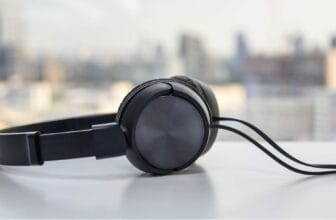
How Important Is Frequency Response in Headphones?
When selecting headphones, have you ever considered how crucial frequency response is to your listening experience? The range of frequencies a headphone can reproduce significantly influences the clarity and accuracy of sound. How well a pair of headphones handles different frequencies can make or break your enjoyment of music—whether it’s feeling the deep thump of a bassline or hearing the delicate nuances of high-pitched notes.
But does a wider frequency response always mean better sound quality? Let’s explore this aspect further to uncover the true importance of frequency response in headphones. See the Recommended Headphones at the end of this Guide.
Understanding Frequency Response in Headphones
To truly grasp the significance of frequency response, you must first understand how it directly impacts your listening experience.
What Is Frequency Response?
Frequency response refers to how well headphones reproduce sound across the range of frequencies audible to the human ear, typically measured in Hertz (Hz).
- The standard range for most headphones is 20 Hz – 20,000 Hz (20 kHz), as this is the general range of human hearing.
- Some premium headphones offer an extended range, such as 5 Hz – 40 kHz, which may help capture richer audio details, especially for high-resolution music formats.
Flat vs. Colored Frequency Response
- Flat Frequency Response: Produces all frequencies equally, without emphasizing any particular range. This is ideal for studio monitoring, mixing, and professional audio work because it provides a neutral, accurate representation of the original sound.
- Colored Frequency Response: Some headphones are designed to emphasize certain frequencies, such as boosted bass or enhanced treble, making music sound more dynamic but less accurate to the original recording.
Knowing the difference between these responses helps in selecting the right headphones for your needs.
Impact on Sound Quality
The frequency response of headphones plays a major role in determining how clear, balanced, and immersive your audio experience is.
1. Bass Frequencies (20 Hz – 250 Hz)
- Deep bass sounds, such as drum beats and bass guitars, fall within this range.
- If the lower frequencies are weak, the sound may lack depth and impact.
- If bass is overemphasized, it can overshadow mid and high frequencies, causing a boomy or muddy sound.
2. Mid Frequencies (250 Hz – 4 kHz)
- This range covers vocals, guitars, pianos, and most instrumental sounds.
- Headphones with balanced mids ensure voices and instruments sound clear and natural.
- If mids are too recessed, voices may sound distant or drowned out by bass and treble.
3. Treble Frequencies (4 kHz – 20 kHz)
- This range captures high-pitched sounds like cymbals, string instruments, and details in vocals.
- Well-balanced treble adds brightness and clarity.
- If treble is too sharp, the sound may become harsh or fatiguing over long listening sessions.
Having a balanced frequency response ensures that no part of the sound spectrum overpowers another, providing better clarity and detail.
Frequency Range and Accuracy: What Matters More?
When evaluating headphones, two factors come into play:
1. Frequency Range
- The frequency range indicates the lowest and highest sounds the headphones can produce.
- While many headphones advertise 5 Hz – 40 kHz, the human ear can only hear from 20 Hz – 20 kHz—so anything beyond that might not be noticeable.
- A wider range doesn’t always mean better sound; it depends on how accurately the headphones reproduce these frequencies.
2. Frequency Accuracy
- Accuracy refers to how well the headphones reproduce each frequency without distortion or artificial boosting.
- Some headphones overemphasize bass or treble to make music sound more exciting, but this distorts the original recording.
- Professional-grade headphones aim for a flat and accurate frequency response for an authentic listening experience.
💡 Example:
- Gaming headsets often boost lower and mid frequencies to enhance gunfire, explosions, and voices.
- Audiophile headphones focus on flat frequency response to provide a more natural sound.
Understanding the balance between range and accuracy will help you pick the right headphones for your needs.
Importance of a Balanced Frequency Response
A balanced frequency response means that all sound frequencies are represented evenly, without overpowering one another.
Why Is This Important?
- Accurate Music Reproduction – Hear music as the artist intended, without artificial enhancements.
- Prevents Listener Fatigue – Overemphasized bass or treble can cause ear strain over time.
- Better Sound Clarity – Every instrument and note is distinct and well-defined.
- Essential for Mixing and Mastering – Studio professionals rely on a neutral frequency response to ensure accurate sound production.
While some people prefer bass-heavy headphones (e.g., Beats by Dre) or treble-enhanced headphones, a well-balanced response ensures the most natural sound experience.
Choosing Headphones Wisely: What to Look For
When selecting headphones, consider the following factors to get the best frequency response for your needs.
1. Music Preference
- Bass-heavy music (Hip-hop, EDM, Rock): Choose headphones with an extended low-frequency range for deep bass.
- Vocal or instrumental music (Jazz, Classical): Look for headphones with balanced mids and highs for clarity.
- All-rounder headphones: Opt for a flat frequency response for a neutral sound.
2. Headphone Type
- Over-Ear Headphones: Generally provide a wider frequency response and better sound quality.
- In-Ear Earbuds: Compact, but may not have the same deep bass response as over-ear models.
- Gaming Headsets: Often tuned to emphasize dialogue and environmental sounds.
3. Wired vs. Bluetooth Headphones
- Wired headphones typically provide a more accurate frequency response with no signal loss.
- Bluetooth headphones may have a limited frequency range due to compression, though newer models with high-resolution codecs (like LDAC and aptX HD) have improved significantly.
Frequently Asked Questions (FAQs)
1. Does headphone frequency response matter?
Yes! It directly affects sound quality, clarity, and accuracy. Choosing the right frequency response ensures a better listening experience.
2. Is a higher Hz better for headphones?
Not necessarily. While a wider range (e.g., 5 Hz – 40 kHz) may improve sound reproduction, accuracy is more important than range.
3. Is 20 Hz – 20 kHz good for headphones?
Yes, this is the standard frequency range for most headphones, covering everything the human ear can perceive.
4. Is a higher frequency response better?
A higher range doesn’t always mean better sound. What matters more is how accurately the headphones reproduce frequencies.
5. How important is frequency response in headphones for gaming?
Very important! Gaming headsets often boost mid and low frequencies to enhance footsteps, gunfire, and explosions, making it easier to locate enemies in competitive gaming.
6. What are the best frequency response headphones?
Some highly-rated headphones for balanced frequency response include:
- Sennheiser HD 600 / 650 – Known for neutral and accurate sound.
- Sony WH-1000XM5 – Great balance of clarity and bass.
- Bose QuietComfort 45 – Excellent for travel and noise isolation.
- Audio-Technica ATH-M50X – Popular for studio use with a flat frequency response.
Final Thoughts: How Much Does Frequency Response Matter?
While frequency response is a critical factor in headphone performance, it’s not the only thing to consider. Sound signature, accuracy, and personal preference all play a role in finding the best headphones for you.
When shopping for headphones, pay attention to:
✅ The balance of bass, mids, and treble
✅ Accuracy over just a wide range
✅ Your listening needs—music, gaming, or studio work
Now that you know what to look for, you’re one step closer to finding headphones that deliver the perfect sound for you! 🎧🔥

I am a USMC Veteran who worked with a Lot of computers and Technology while I was in. I became hooked and learned a lot in my 20 years.
At my store, I am passionate about bringing you the latest tech products that enhance your everyday life. Our mission is to provide quality, innovation, and value, making sure you find the perfect gadgets to fit your needs. Thanks for Your Support.. Larry Mac





